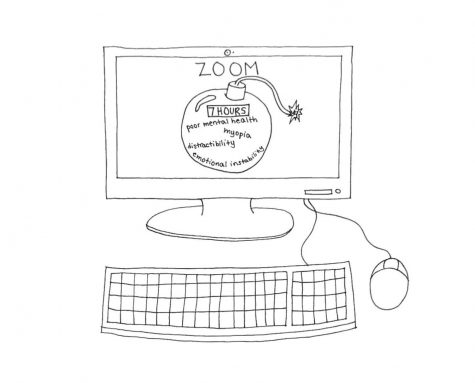Time spent at home has been prolonged by the pandemic, causing screen time to inevitably skyrocket. Since COVID-19 began to spread in March 2020, the majority of schools have switched to online learning, increasing the technology usage of students by more than 60 percent, according to Reid Health. As a student, I spend an average of six to seven hours per day participating in classes on Zoom, which consists of constantly staring at a screen. Furthermore, when school hours conclude, there are at least another two to three hours spent on a computer for homework. Almost every assignment is online, leaving students no choice but to spend most of their days tediously sitting in front of their computer — which can result in serious health issues. Redwood and other schools in distance learning should implement techniques to reduce screen time, provide more breaks during long periods and assign more offline homework.
Excessive screen time provokes several health concerns including myopia, which is nearsightedness. A National Institute of Health (NIH) study of 5,074 children found a connection between increased computer use and myopia. Similarly, another study conducted by the NIH of children ranging from two to 17 years old proved additional impairments from increased screen time, finding an association between moderate use of screens (four hours per day) and lower psychological well-being, less emotional stability, higher distractibility, less curiosity and inability to finish tasks. With most students exceeding four hours on screens just for their school day, the effects are even more damaging.
In response, the NIH recommends limiting electronic teaching to 30 percent of overall teaching time and electronic homework to less than 20 minutes per day. Likewise, according to a February 2021 Non-Fiction survey, 70 percent of students would enjoy a greater amount of offline learning.
To achieve this while still providing students with a strong online education, Alix Gallagher, the director of strategic partnerships for Policy Analysis for California Education, believes that schools should focus on a mixture of lectures and physical activities, according to an interview with the Washington Post. Gallagher emphasized the importance of discussions with both teachers and students to maximize socialization and simulate in-person school. If Redwood could focus on integrating more communicative, collaborative and physical projects between students, that too would help reduce screen time and the risk of mental health issues. Small steps could include having students conduct an at home science lab or do practice problems in a notebook.
Redwood has attempted to combat the issues associated with prolonged screen time by increasing breaks between classes from seven to 10 minutes. Despite this change, these extra three minutes of break are not enough to mitigate the health concerns around screen time. Class periods are now 75 minutes long, whereas they were generally 50 minutes when in person. In addition to shorter periods, students were participating in activities that did not involve screens, such as listening to lectures or completing printed worksheets for the majority of the periods. The NIH advises students to rest their eyes for 10 minutes in between each period of 30-40 minutes when learning virtually; however, Redwood students are given a 10 minute break after 75 minute periods. While their efforts are appreciated, if Redwood aims to take mental health risks seriously, it is crucial that they schedule longer breaks in between classes.
Another way to reduce screen time is by requiring parts of the 75 minute classes to be spent doing activities off screen.
Redwood English teacher Jeff Ryan makes an effort to get hard copy books for his students so that they can look at something other than their computer.
“I don’t want someone having to go and spend another hour or two looking at a screen to do something I asked them to do outside of the time period that is ascribed to English. If I assign outside work, it is to read a book or to do something that is not screen oriented,” Ryan said.
For the well-being of their students, all teachers should enforce ways to help decrease student screen time whenever possible. Teachers can ensure homework is off-screen and also give 10 minute breaks every 30-40 minutes. With these methods in mind, Redwood can limit screen time and therefore reduce the very real risk of mental health issues that increased screen time poses. Student mental health should be top priority, especially with the added stress and turmoil of the pandemic.





